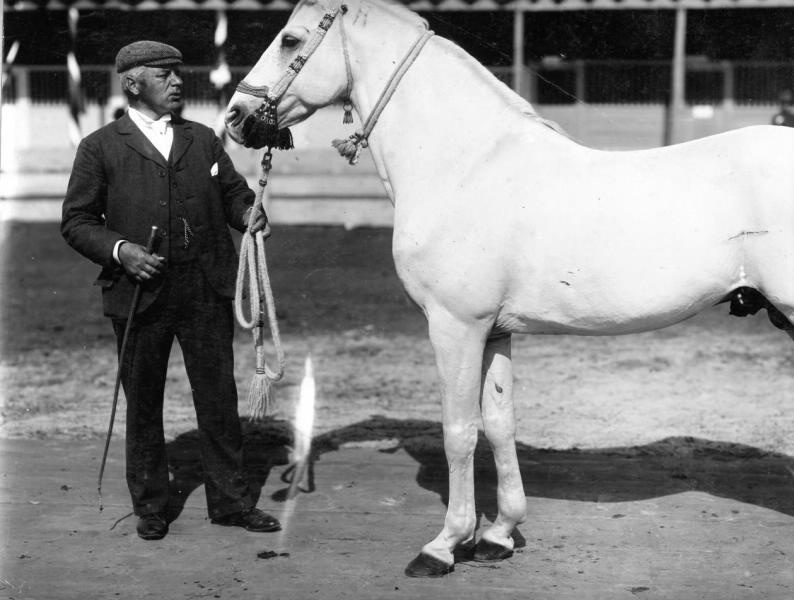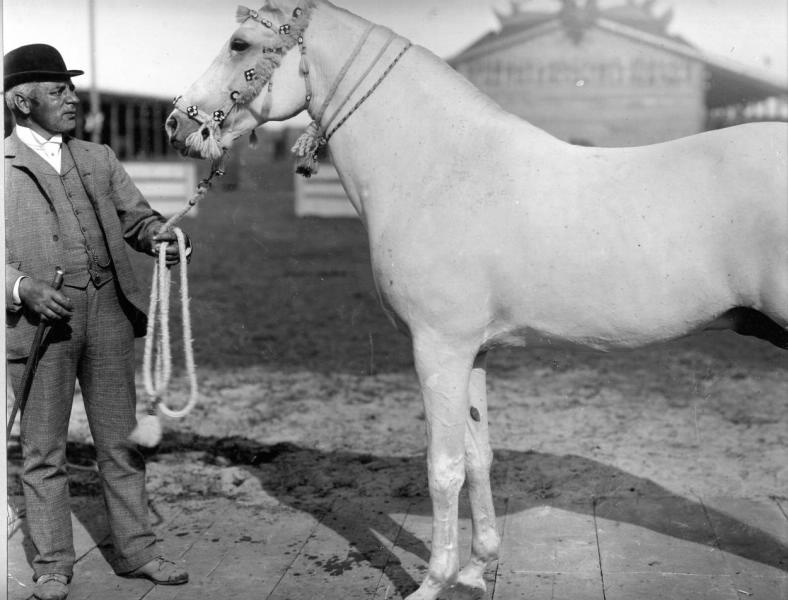Prince Shcherbatov’s desertbred stallions
Prince Alexander Grigorievich Shcherbatov was one of the Russian aristocratic horse breeders, who established an Arabian stud in the late nineteenth century. Together with his brother-in-law, Count Sergei Aleksandrovich Stroganov, Prince Shcherbatov, inspired by the Blunts, journeyed to Syria in 1888, in order to purchase Bedouin Arabian horses. They succeeded in buying horses from the Anazah and the Shammar, and in 1900 made a second trip to Syria.
Neither Shcherbatov nor Stroganov’s studs survived the upheaval of the Russian Revolution, though part of the Tersk stud is situated on Stroganov’s farm.
El-Kader (above), a Kuhaylan Swayti stallion from the Ruwalah, by a Ma’naqi ibn-Sbayli.
Born in Arabia in 1882 at Bedouin Mis’ar Ibn-Moadjil of Ashadjaa tribe (from Roal Anaze). The said Bedouin sold the horse to Ahmet Pasha Shaaman in Damascus where it served as a sire for Roala tribe. Sire of Manegi Ibn-Sbeiyel strain. Purchased by Prince A.G. Shcherbatov in person in Damascus and brought to Russia in 1888.
Stud Book of Arabian horses with their pedigrees present in Russia
Faris (above), an Ubayyan Sharrak stallion from the Shammar, by a Kuhaylan Ras-el-Fedawi.
From Abeyan Sherrak strain, from Gkhenedish family (of Selga Shommar). Pebble grey stallion, imported, height 2 arshins 2 ¼ inches. Born in 1886 in Mesopotamia, and Bedouin tribe Feddara (of Shommar). Sire: red stallion from Kekhaylan Ras-el-Fedauee strain. Purchased personally by Prince A.G. Shcherbatov in Deir on Euphrates from Bedouin of Feddara tribe (of Shommar) and brought to Russia in 1888. Died in 1902.
Stud Book of Arabian Horses etc
Khamad (above), a Kuhaylan Tamri from the Gomussah, sired by a Ma’naqi ibn-Sbayli.
From Kekhaylan Tamri strain. Bay stallion, imported; height 2 arshins 2 inches. Born in 1896 in Arabia at Bedouin Khamad Ibn-Nkheiba of Gomussa tribe (from Sebaa Anaze). Sire: bay stallion of Manegi Ibn-Sbeyel strain, who belonged to Bedouin Ibn-Djnedan of Ibn-Khaddal tribe (from Anaze). Dam: grey mare of Kekhaylan Tamri strain. “Khamad” served as a sire from 1899 for Gomussa, Fedhaan and other Anaze tribes. Purchased personally by Prince A.G. Shcherbatov in Syrian desert in 1900 from the said Khamad Ibn-Nkheiba. Brought to Russia in 1900.
Stud Book of Arabian Horses etc
Photos sourced from the History of Russia in Photographs.



It’s really interesting to me the different phenotypes we are seeing from 19th century imports. El Kader and even Faris remind me quite a bit of the Old English stallion Mootrub.
Cool horses!
What was up with the photographer, though? Wish he’d moved back a couple steps.
I know! On the other hand, could be the photographer, could be the archives. At any rate, half a horse is better than no horse, but also infinitely more tantalising.
Hope it’s the archives & the complete photos exist.
Tantalizing? I want instant gratification! (Serenity now!) -grin-
The sire of the first one (el-Kader) is probably related to the Ma’naqiyah Sbayliyah of Ibn Maajil that was the dam of the old Egyptian stallion Sabbah. She had come to Ahmad Pasha Kamal through the Tahawis.
The second one (Faris) appears to be Ubayyah Sharrak of the strain of Ibn Hunaydees. He is probably related to the Syrian Studbook mare Mouna, a Ubayyah Sharrakiyah of the strain of Ibn Hunaydees of the Shammar. The Shammar tribe referred to is that of the Faddagha.
Thank you for the probable relations of these horses! It is always interesting to learn from you how they are interconnected.
So El-Kader’s breeder Misar Ibn Moadjil is Ibn Maajil (the same Ibn Maajil who owned the dam of Sabbah? Or a relative?), so El-Kader may be connected to Sabbah through his sire and Sabbah’s dam? And if so, then he’d be a distant relation to horses like Balance, Nazeer, Roda, Khafifa, and the other descendants of Sabbah. That’s really neat!